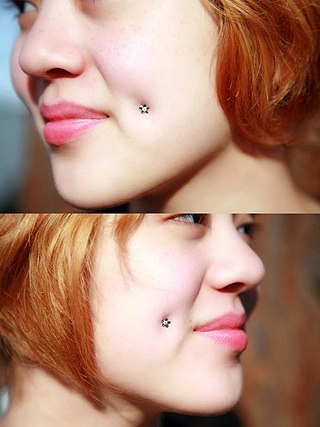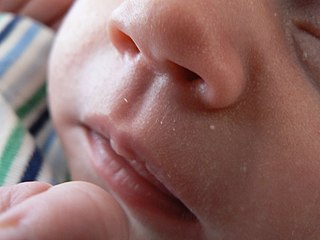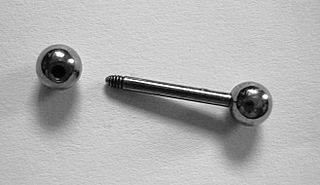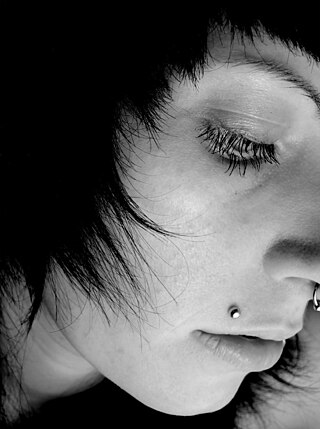
A lip piercing is a type of body piercing that penetrates the lips or the area surrounding the lips, which can be pierced in a variety of ways.

A bridge piercing is a facial piercing through the skin on the bridge of the nose, usually directly between the eyes of the wearer. A variation on this piercing, the vertical bridge piercing is a surface piercing, with all of the risks or potential complications related to surface piercings.

A navel piercing is a type of piercing located through the skin of the navel. It is most commonly located on the upper fold of skin, but can also be effected underneath or around the edges of the navel. It may heal quickly and with no irritations, like an ear piercing, or may heal more like a surface piercing with the associated extended healing time. Healing usually takes around 6–12 months, but varies by person due to differences in physiology. Navel piercings reject less frequently than most other surface piercings, but the rejection rate is nonetheless higher than non-surface piercings. A properly effected navel piercing involves piercing the skin surrounding the navel with the initial wound inside of the navel canal. This can be done at any angle where there is a clear flap of skin, but the most prevalent form of navel piercing is through the upper rim of the navel.

A clitoral hood piercing is a female genital piercing through the clitoral hood surrounding the clitoris. The clitoral hood is homologous with the foreskin in the male reproductive system. In addition to being an adornment, a clitoral hood piercing can enhance sexual pleasure during masturbation, foreplay and intercourse. In an empirical study at the University of South Alabama, the authors reported a positive relationship between vertical clitoral hood piercings and desire, frequency of intercourse, and sexual arousal. There are two main types of clitoral hood piercing: the vertical clitoral hood (VCH) piercing and the horizontal clitoral hood (HCH) piercing. As the names indicate, the difference is in the direction the piercing is oriented in the skin above the clitoris. Neither of these piercings penetrates the clitoris itself, although in common parlance they are sometimes called "clit" piercings. The deep hood piercing is a variation of the clitoral hood piercing that passes deeper through the clitoral hood.

Cheek piercing is facial body piercing through the cheek. The most common variation of the cheek piercing penetrates the facial tissue into the oral cavity. The usual placement is symmetrical on either side of the face, either penetrating or imitating dimples. The piercing can cause the wearer slight nerve damage and will result in "man-made dimples". An alternative is microdermal implants, placed in the intended dimple location. This method avoids drawbacks of full cheek piercings, which have a tendency to leak or secrete lymph fluid, which has a saliva-like texture and can create an unpleasant odor. Though microdermals do have a slightly larger chance to leave a scar than a piercing, they will heal eventually and be almost unnoticeable. The rate of infection is also lower in the long run. Because the piercing does not penetrate the cheek completely, there is little to no chance of tooth or gum damage. Microdermals are like a 'one hole' piercing, where the 'foot' of the jewelry sits below the skin and the decorative jewel or flat disc is above the skin.

The philtrum, or medial cleft, is a vertical indentation in the middle area of the upper lip, common to therian mammals, extending in humans from the nasal septum to the tubercle of the upper lip. Together with a glandular rhinarium and slit-like nostrils, it is believed to constitute the primitive condition for at least therian mammals. Monotremes lack a philtrum, though this could be due to the specialised, beak-like jaws in living species.

A labret is a form of body piercing. Taken literally, it is any type of adornment that is attached to the lip (labrum). However, the term usually refers to a piercing that is below the bottom lip, above the chin. It is sometimes referred to as a "tongue pillar" or a "soul patch piercing".
Body piercing jewelry is jewelry manufactured specifically for use in body piercing. The jewelry involved in the art of body piercing comes in a wide variety of shapes and sizes in order to best fit the pierced site. Jewelry may be worn for fashion, cultural tradition, religious beliefs, personal symbolism, and many other reasons.

Barbell style piercing jewelry is composed of a straight bar with a bead on each end, one or both beads unscrewable for removal and/or changing of the beads. Often one of the beads is fixed, either via epoxy or welding, so that only one bead is used to install or remove the jewelry. Barbell threads are usually right-handed.
Scalpelling is a body art procedure similar to body piercing for the creation of decorative perforations through the skin and other body tissue, and is most commonly used as a replacement for or enhancement of ear piercing. Whereas piercing is typically performed with a hollow piercing needle or an ear piercing instrument, scalpelling is performed by using a scalpel to cut a slit into the skin. Unlike dermal punching, no flesh is removed. The technique can immediately produce holes with a larger diameter than can be achieved by piercing. This is a more rapid means of accommodating larger gauge jewellery than stretching, a technique whereby piercings are enlarged by inserting gradually larger jewellery. Scalpelling is performed to quickly achieve a large-gauge piercing, when scar tissue is preventing further stretching, if tissue has thinned to the point where further stretching could cause it to break, or to combine two closely placed piercings into one hole.

The lips are a horizontal pair of soft appendages attached to the jaws and are the most visible part of the mouth of many animals, including humans. Vertebrate lips are soft, movable and serve to facilitate the ingestion of food and the articulation of sound and speech. Human lips are also a somatosensory organ, and can be an erogenous zone when used in kissing and other acts of intimacy.

An anti-eyebrow is a facial piercing that is placed above the cheek bone or below the eyebrow. Normally it is done with a small surface bar. This piercing can be vertical or horizontal, depending on the person's preference. Though it is a surface piercing, with proper care, placement, and jewelry, it can be a viable long-term piercing. Long-term viability is best with proper surface bars, and significantly reduced when barbells, or curved barbells are used. Often reputable piercers will refuse to do surface piercings, instead preferring sub-dermal implants.

The lip plate, also known as a lip plug, lip disc, or mouth plate, is a form of body modification. Increasingly large discs are inserted into a pierced hole in either the upper or lower lip, or both, thereby stretching it. The term labret denotes all kinds of pierced-lip ornaments, including plates and plugs.

A lip frenulum piercing is a body piercing through the frenulum of either the upper or lower lip. A piercing through the upper lip frenulum is sometimes called a "smiley", because it is usually only seen when smiling, or a "scrumper". Similarly, the lower lip frenulum piercing is sometimes referred to as a "frowny". Jewelry is recommended to be worn in the piercing for a short period of time because the risks associated with it are high.

A Monroe piercing is a lip piercing placed off-center, above the upper lip on the left-hand side and is meant to resemble Marilyn Monroe's beauty spot, although Monroe's beauty spot was on her cheek, not her lip. The Madonna piercing is similar but worn on the right-hand side.

A philtrum piercing, nicknamed a medusa piercing, is an upper lip piercing placed in the philtrum, directly under the septum of the nose. It is typically pierced using a labret stud as jewelry, with the ball sitting outside the mouth in the dip of the top lip.
Lip reconstruction may be required after trauma or surgical excision. The lips are considered the beginning of the oral cavity and are the most common site of oral cancer. Any reconstruction of the lips must include both functional and cosmetic considerations. The lips are necessary for speech, facial expression, and eating. Because of their prominent location on the face, even small abnormalities can be apparent.

Body piercing, which is a form of body modification, is the practice of puncturing or cutting a part of the human body, creating an opening in which jewelry may be worn, or where an implant could be inserted. The word piercing can refer to the act or practice of body piercing, or to an opening in the body created by this act or practice. It can also, by metonymy, refer to the resulting decoration, or to the decorative jewelry used. Piercing implants alter the body and/or skin profile and appearance. Although the history of body piercing is obscured by popular misinformation and by a lack of scholarly reference, ample evidence exists to document that it has been practiced in various forms by multiple sexes since ancient times throughout the world. Body piercing can be performed on people of all ages, although most minors are only permitted to have earlobe piercings.

The serpent labret with articulated tongue is a gold Aztec lip plug from the mid-second millennium AD. Made of a gold, copper and silver alloy, it was cast via the lost-wax process; the tongue, cast individually, can be retracted or extended, and swings from side to side with its wearer's movement. The serpent is thought to represent Xiuhcoatl. The labret entered the collection of the Metropolitan Museum of Art with a 2016 purchase, and is considered "perhaps the finest Aztec gold ornament to survive the crucibles of the sixteenth century".
















